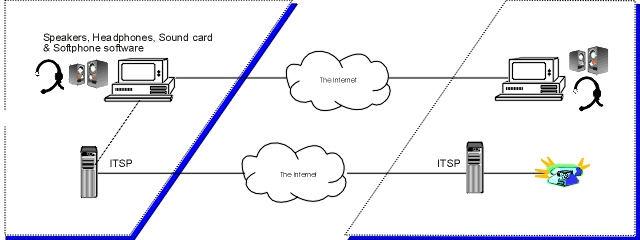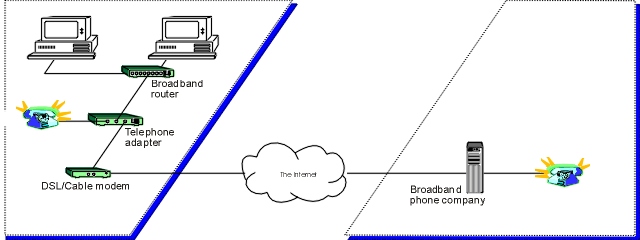Voice over IP Online Course
Lesson 1 - Voice over IP Overview
B. Residential/Small Business VoIP
Residential/Small Business VoIP
- Voice over the Internet
- Computer to computer
- Internet Telephone Service Provider
- Quality of service is variable
- Residential VoIP (broadband telephone)
Voice over the Internet
Internet telephone lets you make long-distance calls over the Internet right from your computer. The driving force behind the development of these software tools is the money users can save on long distance charges. The Internet phone was particularly alluring when long distance telephone charges were high. Since the advent of serious price competition in this field, the charges for long distance in North America have dropped extremely low so this exercise may not be worth the effort if your long distance needs are minimal. However, if you often make telephone calls to places outside North America, for business or family, you may find some serious savings in Internet telephone.In this section we will explore the different forms that Internet telephone takes - computer to computer and computer to person via an ITSP (Internet Telephony Service Provider).

Figure 1: Voice over the Internet
Computer to computer
You can use computer to computer Internet telephone if the computers at both ends of the conversation are similarly equipped with a sound card, microphone and speakers, a headset or a USB telephone. Then, all you need is the right software and you can start talking.
This is a relatively new field in software. The first product came on the market in 1994. Pioneered by Vocal Tec, Internet Phone is still a leader in its field. Others soon followed, such as Web Phone and Microsoft’s NetMeeting. Currently the market leader with the most mind share is Skype. It's web site claims 173 million downloads at this writing.Internet telephone software may be free or only cost a modest amount, and certainly the avoidance of long distance charges is compelling. So what is the catch?
Computer to computer Internet telephone is not without its wrinkles- Both computers have to be similarly equipped with sound cards, speakers and microphones. So obviously you can’t phone just anyone. You need to know if the other user is equipped to receive your call.
- Both computers have to be running the same Internet telephone software.
- Both machines have to be up and running plus logged onto the Internet, otherwise, how will the receiving machine “ring” when the call is coming in?
- The sound quality can range from good to very poor. After all, it is traveling over the Internet and sound quality cannot be guaranteed.
Internet Telephony Service Provider (ITSP)
After looking at the way the computer to computer telephone service works, you can see one huge flaw. What if the other party doesn’t have a computer, let alone all of the goodies to make the telephone service work? The alternative is to enlist the aid of an ITSP.An ITSP will take your Internet telephone call and place it onto the national telephone system of the person you are calling. As the originator of the call, your computer must be set up just as is required for computer to computer telephone; namely you will need the sound card, speakers and microphone. However, the recipient will receive a real telephone call and can talk to you using their regular telephone hand set so you have no worries about computer hardware and software capabilities at the other end.
The ITSP will take your call either at a local server and send it across a private network to the destination country, or send your call across the Internet to the ITSP’s node in the remote country. In either case, the ITSP must have a server in the remote country that transfers the call to the national telephone system. It is important to know this limitation if you are trying to call someone in a country that is not well served by the Internet.
Figure 2: Residential VoIP
Residential VoIP
Residential VoIP makes a regular telephone service available over a broadband Internet connection. The Internet connection can be either DSL or cable. The providers of this type of service offer telephone service at very low rates in comparison to the legacy telephone companies.Standard telephone features are included with the service including voicemail, call waiting and call forwarding. There are two surprising features which cannot be duplicated by the traditional telephone companies.
- Virtual telephone numbers - this option will assign an additional telephone number to you from another area code. Anyone calling you from that area code will dial a local number thereby avoiding all long distance charges.
- Telephone number portability - this means that you can take your telephone adapter with you if you travel and anyone calling your local number will reach you wherever you are. Naturally, you will need to find a highspeed Internet connection at your destination. But since many hotels now offer a high speed service, this is a practical option.
[Top of page][On to next section]
